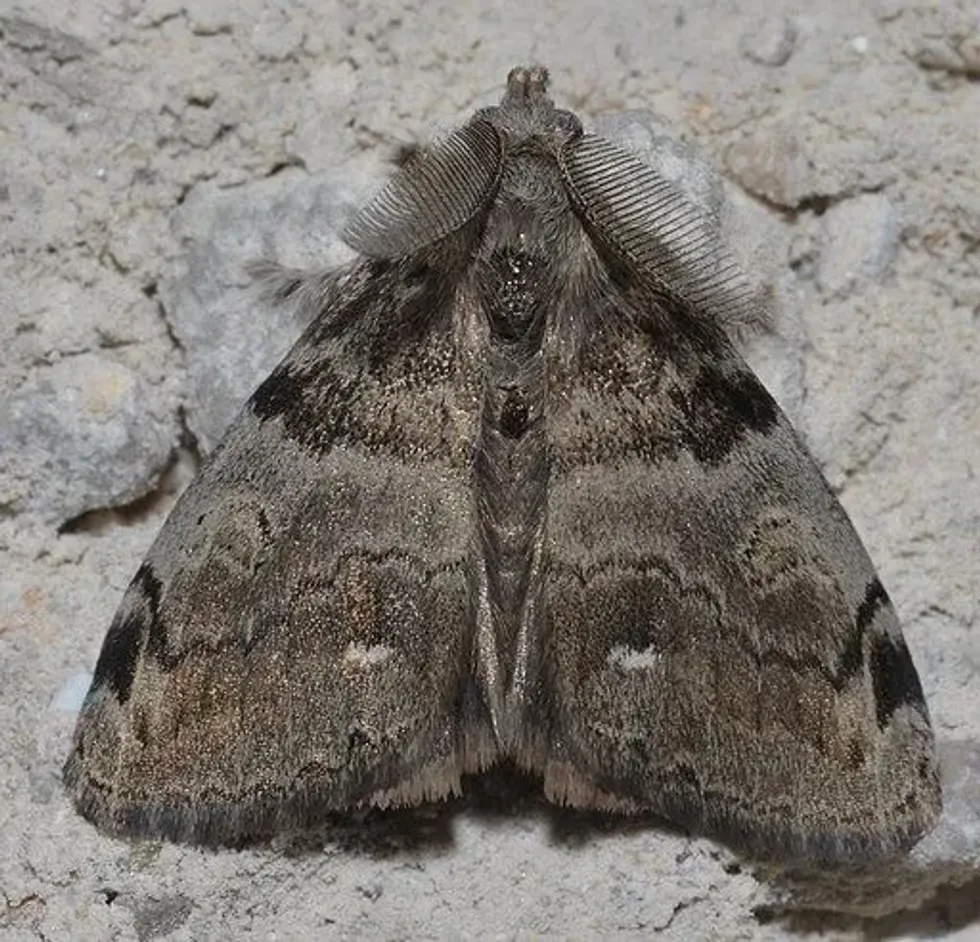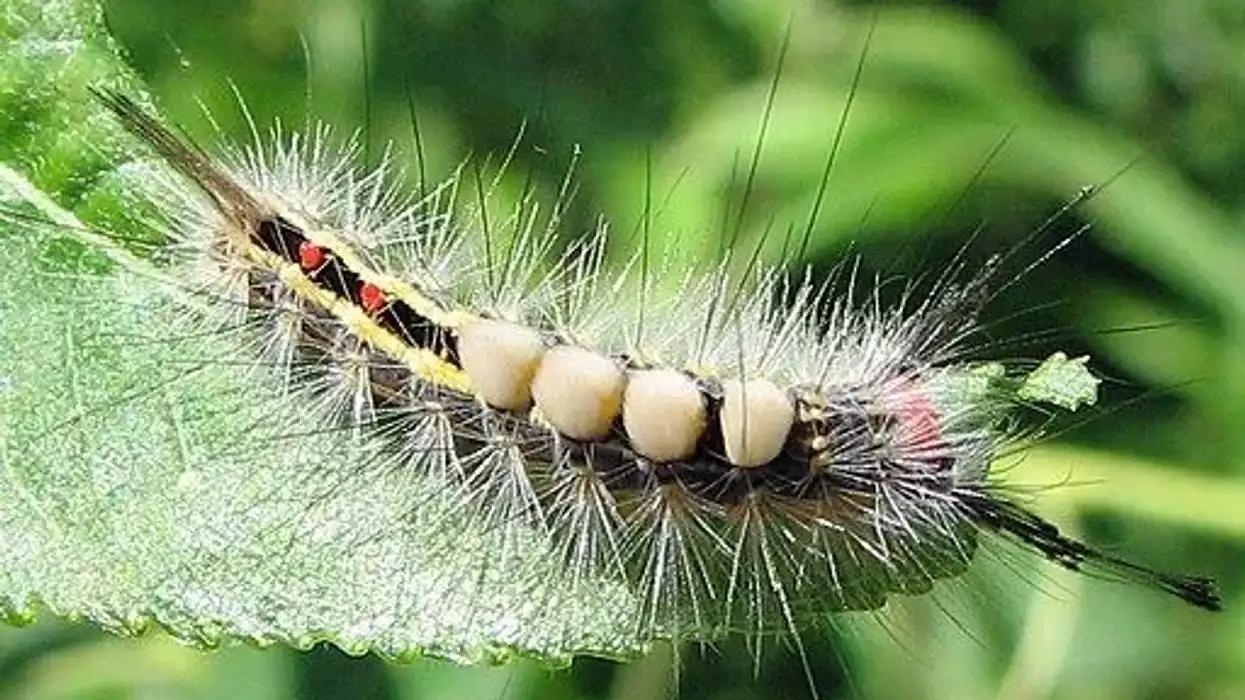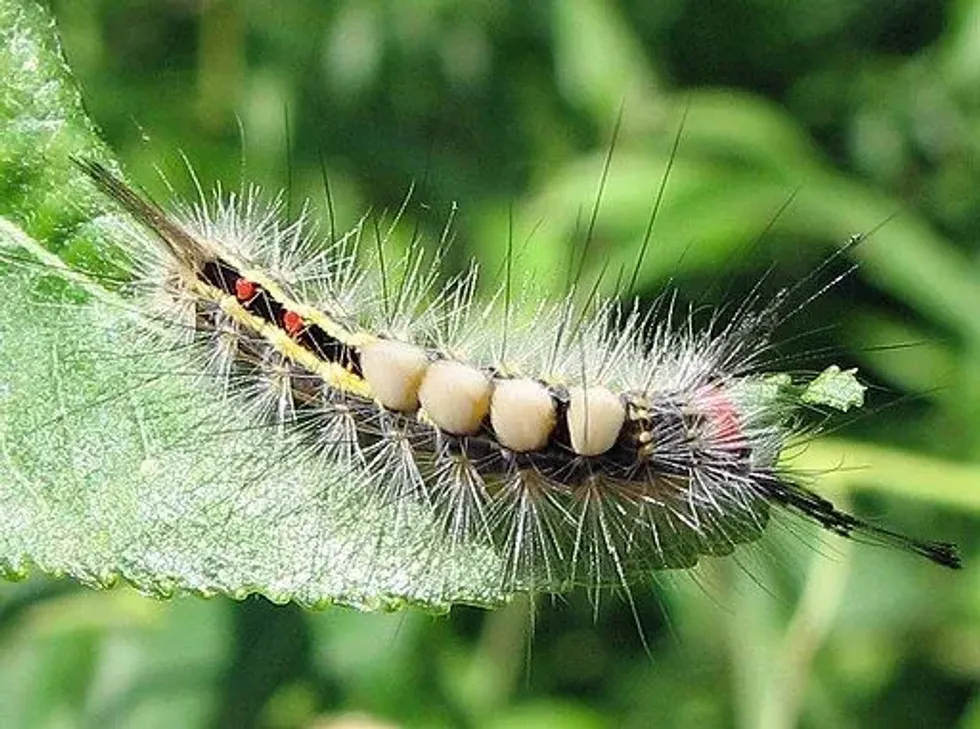Fun White Marked Tussock Moth Facts For Kids
The white marked tussock moth is a fairly common moth found in parts of the USA and Canada. Its scientific name is Orgyia leucostigma.
Its genus name Orgyia is from the Greek word for ‘outstretched arms’. This name was given because when the moth is resting, it stretches out its forelegs in front, making them look like arms. Over the summer, between April to June, the caterpillars eat their way through the leaves of a wide variety of trees.
They are not picky at all. They feed on over 140 species of trees.
Every year, these moths lay eggs over the winter. The females can lay up to 300 eggs in a frothy mass on top of their cocoon.
Almost all the eggs hatch into caterpillars, which means that in some years, this moth is considered a minor pest. Outbreaks of this moth can result in large forests of trees losing their foliage, especially shade and ornamental trees.
Additionally, this moth has evolved a defense mechanism where the caterpillars are covered in white hairs in tufts. These hairs can cause allergic reactions in people who have sensitive skin. In fact, any hairs left behind in the caterpillar cocoons can cause allergic reactions up to a year later!
Included in this article are information such as white marked tussock moth feeding habits, adult white marked tussock moth caterpillar larger veins, white marked tussock moth egg stage, white marked tussock moth on Christmas tree, white marked tussock moth host plants, white marked tussock moth larval stage, and so on.
You may also check out the fact files on gypsy moths and rosy maple moths from Kidadl.
White-Marked Tussock Moth Interesting Facts
What type of animal is a white-marked tussock moth?
The white marked tussock moth (Orgyia leucostigma) is a moth in the family Erbidae, of the order Lepidoptera.
What class of animal does a white marked tussock moth belong to?
Moths, like butterflies, are arthropods, belonging to the class Insecta.
How many white-marked tussock moths are there in the world?
The exact number of the white-marked tussock moth is unknown! This species is abundant in nature, so their numbers are not being closely monitored.
Where does a white-marked tussock moth live?
The white-marked tussock moth lives in the woods, feeding off the foliage of a wide variety of trees.
What is a white-marked tussock moth's habitat?
This moth thrives in warm climates. For this reason, the white marked tussock moth is found in the subtropical regions of eastern North America. This includes the entirety of Eastern USA, Coastal regions of USA, and some parts of Canada like Alberta, Quebec, and Nova Scotia.
Who does the white-marked tussock moth live with?
Moths, like butterflies, are solitary creatures. They prefer to live alone. After they hatch, all the white marked tussock moth caterpillars go their own way, feeding till they are ready to become moths.
During mating season, the males find the females based on their scents, and the life cycle continues.
How long does a white-marked tussock moth live?
The white-marked tussock moths hatch after the winter and stay as caterpillars for about 30-40 days. Then the caterpillars pupate and become moths that lay eggs again in September. Since the white-marked tussock moths thrive in summer, they live for around five to six months from hatching till laying their own eggs in September.
How do they reproduce?
Just like most individuals of the order Lepidoptera, the white marked tussock moth, Orgyia leucostigma, reproduces by laying eggs.
The female moths have underdeveloped wings, making them flightless. They release pheromones to attract males during mating season. The males fly to them, and after mating, the females lay a large mass of eggs on old cocoons. There can be up to 300 eggs in a mass!
Usually, two generations of moths are hatched in a year.
What is their conservation status?
This species of moth is Not Endangered. It is in fact fairly common, enough to be considered a pest. This is why the species is not listed on the IUCN Red List of Threatened Species and does not have conservation status.
White Marked Tussock Moth Fun Facts
What does the white-marked tussock moth look like?

The white marked tussock moth (Orgyia leucostigma) is named for two reasons. The Genus name Orgyia is for its tendency to stretch out forelegs, like arms.
The species name, ‘leucostigma’ is from the Greek words ‘leuco’, meaning white, and ‘stigma,’ meaning mark or spot. This refers to the white spots on the base of the fore wings (front wings) of the males.
The males are brownish-gray, with brown banded wings with a single spot on each forewing. On the other hand, the females have underdeveloped wings, so they can’t fly. They may as well be wingless. They have feathery antennae. Both males and females are hairy, but the hair is most visible in females.
The white marked tussock moth caterpillar is a very beautifully colored caterpillar, that has tufts of white hairs on its back. It has a bright red head and a black body with yellow bands.
It could also have yellow and black stripes on a blue-gray body. These might make it look cute, but the hair tufts can be dangerous, so they shouldn’t be touched!
How cute are they?
Being individuals of the order Lepidoptera, the white marked tussock moths are a type of insect.
While there are moths with colorful wings, these moths are fairly neutrally colored. If you think insects are cute, you might think these fuzzy moths are cute, especially the females!
How do they communicate?
Moths and butterflies communicate in a number of ways, depending on the species. In the case of the white-marked tussock moth, Orgyia leucostigma, the primary mode of communication is scent.
These moths are solitary, so the only time they need to communicate is during mating season. For this reason, they have evolved antennae, which have highly developed scent organs. These organs allow the males to smell the pheromones or chemicals released by the females during mating season. They follow this smell to find the females and mate.
How big is a white-marked tussock moth?
The average wingspan of a white marked tussock moth is about 1-1.2 in (2.5-3 cm). This is relatively smaller than the wingspan of the puss moth, which is 2.3-3 in (5.8-7.6 cm). However, these moths are actually quite small when you compare them to the monarch butterfly, which has a wingspan of 3-4 in (7.6-10.1 cm)!
This means that the white-marked tussock moth is three to four times smaller than the monarch butterfly!
How fast can a white-marked tussock moth fly?
There is no specific information about how fast a white-marked tussock moth can fly. Of course, the females of this species cannot fly at all!
But scientists have studied moths and discovered that some species of moths can fly as fast as songbirds. Moths have reached speeds between 18.6-40 mph (30-64.3 kph) across the species! So we can assume that the white-marked tussock moth might be able to fly pretty fast.
How much does a white-marked tussock moth weigh?
Moths, butterflies, and other insects are typically measured on the basis of their wingspan. This is because they are very small, and generally do not weigh a lot. Insects that fly need to be even light to make sure that their wings can carry the weight.
While there is no information about how much a white marked tussock moth weighs, butterflies and moths generally weigh less than1 oz (28.3 g).
What are the male and female names of the species?
When it comes to moths and butterflies, the males and females of the species do not have separate names. So a male white marked tussock moth is simply called a male moth. Similarly, the female white-marked tussock moth is called a female moth.
What would you call a baby white marked tussock moth?
Depending on how long it has been since they hatched, the babies of the white-marked tussock moth are called by different names.
When they first hatch, they are called ‘larvae,’ which is the plural of ‘larva’. As they grow to their full adult size of 1-1.5 in (2.5-3.8 cm), they begin to be referred to as ‘caterpillars’. But caterpillars and larvae both mean the same thing, so grown caterpillars may still be called larvae.
What do they eat?
The white-marked tussock moth caterpillar lives off the foliage of woody trees and plants. This means that their food comprises of the leaves from a large variety of trees and shrubs endemic to North America.
They are known to eat from over 140 species of deciduous and coniferous trees. In the years when a lot of tussock moths are hatched at once, they are considered a serious forest pest in Eastern North America.
The caterpillars of these moths can eat so much and so quickly that trees can be completely stripped of their leaves in around 30-40 days. While young trees might survive this, older trees will not.
They are especially dangerous on shade and ornamental trees, as well as trees like pecan, hickory, oak, willow, and walnut. Leaves of woody shrubs and plants are also caterpillar food.
Are they dangerous?
The white-marked tussock moth’s caterpillars can be dangerous to human beings if handled.
The larvae and caterpillars have tufts of hair throughout their body. This hair can fall off or be shed into their cocoons. While it isn’t poisonous, the hairs from these caterpillars can cause severe allergic reactions to people who are sensitive to them.
Additionally, these hairs remain an allergen even up to a year after they have fallen off. So even brushing across old cocoons can result in you breaking out into rashes!
Would they make a good pet?
Moths are considered wild animals, who have specific dietary and environmental requirements to ensure their survival. You will not be able to give them the right kind of food or space to live, even though they might be safe from predators. These are considered invasive species as they damage trees in regions that they inhabit.
The white marked tussock moth, in particular, is a solitary moth, and its caterpillars also have hair that is dangerous to humans. This makes it a very bad candidate to be a pet for human beings.
Did you know...
The male white-marked tussock moths have larger antennae than the females. This is to allow the males to easily smell the pheromones released by the females during mating season.
While the male white-marked tussock moths are ash grey with brown banded wings, the females are white and hairy. The caterpillars on the other hand are very colorful! They have bright red heads, black bodies with yellow bands, or blue-gray bodies with a single black stripe down the middle.
When the caterpillars are ready to pupate, they make cocoons out of their hair and the silk that they produce. This cocoon is usually found on the trunks or branches of the trees that the caterpillars were eating from. Once the new adults emerge after two weeks, the females stick around while the males fly away.
The females lay their eggs on their old cocoons in winter. As soon as they lay eggs, they die and fall to the ground.
When the caterpillars emerge from the eggs, they disperse to the trees and plants around them. They do this by using the bits of their egg mass and silk to make ‘balloons’ that catch the wind and help them float. These larvae then disperse around their host plants and trees to the others in the area.
Are tussock moths good or bad?
All species are important for diversity and are essential for a healthy ecosystem.
Sometimes, when the White Marked Tussock moths have too many larvae, they can destroy their hosts' plants and trees like oak and willow. They end up eating all the leaves faster than the tree can produce new ones. The young trees are less susceptible than older ones.
This makes them forest pests. They are also pests in orchards of trees like pecan and walnut, oak, willow, and Christmas trees in parts of North America.
What kills tussock moth caterpillars?
The populations of the white-marked tussock moths are controlled by predators like birds, which eat the larvae, and parasites. When they turn into pests, people might deliberately use these parasites or specific bacteria like Bacillus thuringiensis that infest the larvae to kill them.
Here at Kidadl, we have carefully created lots of interesting family-friendly animal facts for everyone to discover! Learn more about some other arthropods from our luna moth facts and crane fly facts pages.
You can even occupy yourself at home by coloring in one of our White Marked Tussock Moth coloring pages.
We Want Your Photos!
More for You
Bachelor of Arts and Law specializing in Political Science and Intellectual Property Rights

Anusuya MukherjeeBachelor of Arts and Law specializing in Political Science and Intellectual Property Rights
With a wealth of international experience spanning Europe, Africa, North America, and the Middle East, Anusuya brings a unique perspective to her work as a Content Assistant and Content Updating Coordinator. She holds a law degree from India and has practiced law in India and Kuwait. Anusuya is a fan of rap music and enjoys a good cup of coffee in her free time. Currently, she is working on her novel, "Mr. Ivory Merchant".
Disclaimer
1) Kidadl is independent and to make our service free to you the reader we are supported by advertising. We hope you love our recommendations for products and services! What we suggest is selected independently by the Kidadl team. If you purchase using the Buy Now button we may earn a small commission. This does not influence our choices. Prices are correct and items are available at the time the article was published but we cannot guarantee that on the time of reading. Please note that Kidadl is a participant in the Amazon Services LLC Associates Program, an affiliate advertising program designed to provide a means for sites to earn advertising fees by advertising and linking to Amazon. We also link to other websites, but are not responsible for their content.
2) At Kidadl, we strive to recommend the very best activities and events. We will always aim to give you accurate information at the date of publication - however, information does change, so it’s important you do your own research, double-check and make the decision that is right for your family. We recognise that not all activities and ideas are appropriate for all children and families or in all circumstances. Our recommended activities are based on age but these are a guide. We recommend that these ideas are used as inspiration, that ideas are undertaken with appropriate adult supervision, and that each adult uses their own discretion and knowledge of their children to consider the safety and suitability. Kidadl cannot accept liability for the execution of these ideas, and parental supervision is advised at all times, as safety is paramount. Anyone using the information provided by Kidadl does so at their own risk and we can not accept liability if things go wrong.
3) Because we are an educational resource, we have quotes and facts about a range of historical and modern figures. We do not endorse the actions of or rhetoric of all the people included in these collections, but we think they are important for growing minds to learn about under the guidance of parents or guardians.







